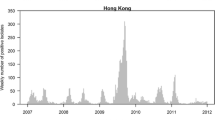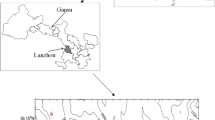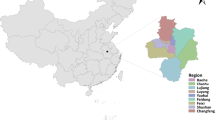Abstract
Accumulating evidence demonstrates the significant influence of weather factors, especially temperature and humidity, on influenza seasonality. However, it is still unclear whether temperature variation within the same day, that is diurnal temperature range (DTR), is related to influenza seasonality. In addition, the different effects of weather factors on influenza seasonality across age groups have not been well documented in previous studies. Our study aims to explore the effects of DTR and humidity on influenza seasonality, and the differences in the association between weather factors and influenza seasonality among different age groups in Hong Kong, China. Generalized additive models were conducted to flexibly assess the impact of DTR, absolute humidity (vapor pressure, VP), and relative humidity on influenza seasonality in Hong Kong, China, from January 2012 to December 2016. Stratified analyses were performed to determine if the effects of weather factors differ across age groups (< 5, 5–9, 10–64, and > 64 years). The results suggested that DTR, absolute humidity, and relative humidity were significantly related to influenza seasonality in dry period (when VP is less than 20 mb), while no significant association was found in humid period (when VP is greater than 20 mb). The percentage changes of hospitalization rates due to influenza associated with per unit increase of weather factors in the very young children (age 0–4) and the elderly (age 65+) were higher than that in the adults (age 10–64). Diurnal temperature range is significantly associated with influenza seasonality in dry period, and the effects of weather factors differ across age groups in Hong Kong, China.



Similar content being viewed by others
Abbreviations
- AIC:
-
Akaike information criterion
- DTR:
-
diurnal temperature range
- GAM:
-
generalized additive regression model
- LAB%:
-
laboratory-confirmed influenza-positive rate
- RH:
-
relative humidity
- VP:
-
vapor pressure
- WS:
-
wind speed.
References
Beard F, Mcintyre P, Gidding H, Watson M (2006) Influenza related hospitalisations in Sydney, New South Wales, Australia. Arch Dis Child 91:20–25
Braganza K, Karoly DJ, Arblaster JM (2004) Diurnal temperature range as an index of global climate change during the twentieth century. Geophys Res Lett 31:405–407
Chan PK, Mok HY, Lee TC, Chu IM, Lam WY, Sung JJ (2009) Seasonal influenza activity in Hong Kong and its association with meteorological variations. J Med Virol 81:1797–1806
Demirci E, Cuhadaroglu B (2000) Statistical analysis of wind circulation and air pollution in urban Trabzon. Energy Build 31:49–53. https://doi.org/10.1016/S0378-7788(99)00002-X
Dowell SF (2001) Seasonal variation in host susceptibility and cycles of certain infectious diseases. Emerg Infect Dis 7:369–374
Feng C, Li J, Sun W, Zhang Y, Wang Q (2016) Impact of ambient fine particulate matter (PM 2.5) exposure on the risk of influenza-like-illness: a time-series analysis in Beijing, China. Environ Health 15:17
Fleming D, Harcourt S, Smith G (2003) Influenza and adult hospital admissions for respiratory conditions in England 1989-2001. Commun Dis Public Health 6:231
Fleming DM, Elliot AJ (2005) The impact of influenza on the health and health care utilisation of elderly people. Vaccine 23(Suppl 1):S1
Graudenz GS, Landgraf RG, Jancar S, Tribess A, Fonseca SG, Faé KC, Kalil J (2006) The role of allergic rhinitis in nasal responses to sudden temperature changes. J Allergy Clin Immunol 118:1126–1132
Hair JF Jr, Anderson RE, Tatham RL, Black WC (1995) Multivariate data analysis, 3rd edn. Macmillan Publishing Company, New York
Hambling MH (1964) Survival of the respiratory syncytial virus during storage under various conditions. Br J Exp Pathol 45:647
Hammond GW, Raddatz RL, Gelskey DE (1989) Impact of atmospheric dispersion and transport of viral aerosols on the epidemiology of influenza. Rev Infect Dis 11:494–497
Hong Kong Centre for Health Protection (2017) Flu Express. http://www.chp.gov.hk/en/guideline1_year/29/134/441/304.html. Accessed 12 Feb 2017
Huang X, Mengersen K, Milinovich G, Hu W (2017) Effect of weather variability on seasonal influenza among different age groups in Queensland, Australia: a Bayesian spatiotemporal analysis. J Infect Dis 215:1695–1701. https://doi.org/10.1093/infdis/jix181
Imai Y, Nobuoka S, Nagashima J, Awaya T, Aono J, Miyake F, Murayma M (1998) Acute myocardial infarction induced by alternating exposure to heat in a sauna and rapid cooling in cold water. Cardiology 90:299–301
Izurieta HS, Thompson WW, Kramarz P, Shay DK, Davis RL, DeStefano F, Black S, Shinefield H, Fukuda K (2000) Influenza and the rates of hospitalization for respiratory disease among infants and young children. N Engl J Med 342:232–239
Kang I, Hong MS, Nolasco H, Park SH, Dan JM, Choi JY, Craft J (2004) Age-associated change in the frequency of memory CD4+ T cells impairs long term CD4+ T cell responses to influenza vaccine. J Immunol (Baltimore MD 1950) 173:673–681
Lin YK, Wang YC, Lin PL, Li MH, Ho TJ (2013) Relationships between cold-temperature indices and all causes and cardiopulmonary morbidity and mortality in a subtropical island. Sci Total Environ 461-462:627–635. https://doi.org/10.1016/j.scitotenv.2013.05.030
Liu L, Breitner S, Pan X, Franck U, Leitte AM, Wiedensohler A, von Klot S, Wichmann HE, Peters A, Schneider A (2011) Associations between air temperature and cardio-respiratory mortality in the urban area of Beijing, China: a time-series analysis. Environ Health 10:51
Lowen A, Steel J, Mubareka S, Palese P (2008) High temperature (30 degrees C) blocks aerosol but not contact transmission of influenza virus. J Virol 82:5650–5652
Lowen AC, Samira M, John S, Peter P (2007) Influenza virus transmission is dependent on relative humidity and temperature. PLoS Pathog 3:1470–1476
Luurila OJ (1980) Arrhythmias and other cardiovascular responses during Finnish sauna and exercise testing in healthy men and post-myocardial infarction patients. Acta Medica Scand Suppl 641:1–60
Marquaridt DW (1970) Generalized inverses, ridge regression, biased linear estimation, and nonlinear estimation. Technometrics 12:591–612
McDevitt J, Rudnick S, First M, Spengler J (2010) Role of absolute humidity in the inactivation of influenza viruses on stainless steel surfaces at elevated temperatures. Appl Environ Microbiol 76:3943–3947. https://doi.org/10.1128/aem.02674-09
Mullooly JP, Bennett MD, Hornbrook MC, Barker WH, Williams WW, Patriarca PA, Rhodes PH (1994) Influenza vaccination programs for elderly persons: cost-effectiveness in a health maintenance organization. Ann Intern Med 121:947–952
Neuzil KM, Mellen BG, Wright PF, Jr MEF, Griffin MR (2000) The effect of influenza on hospitalizations, outpatient visits, and courses of antibiotics in children. N Engl J Med 342:225–231
O’brien RM (2007) A caution regarding rules of thumb for variance inflation factors. Quality & Quantity 41:673–690. https://doi.org/10.1007/s11135-006-9018-6
Ramsay TO, Burnett RT, Krewski D (2003) The effect of concurvity in generalized additive models linking mortality to ambient particulate. Matter Epidemiol 14:18–23
Rechsteiner J, Winkler K (1969) Inactivation of respiratory syncytial virus in aerosol. J Gen Virol 5:405–410
Rigby M, Toumi R (2008) London air pollution climatology: indirect evidence for urban boundary layer height and wind speed enhancement. Atmos Environ 42:4932–4947
Ruf BR, Knuf M (2014) The burden of seasonal and pandemic influenza in infants and children. Eur J Pediatr 173:265–276
Schaffer F, Soergel M, Straube D (1976) Survival of airborne influenza virus: effects of propagating host, relative humidity, and composition of spray fluids. Arch Virol 51:263–273
Shaman J, Kohn M (2009) Absolute humidity modulates influenza survival, transmission, and seasonality. Proc Natl Acad Sci U S A 106:3243–3248. https://doi.org/10.1073/pnas.0806852106
Simonsen L (1998) Pandemic versus epidemic influenza mortality: a pattern of changing age distribution. J Infect Dis 178:53–60
Siple PA, Passel CF (1999) Measurements of dry atmospheric cooling in subfreezing temperatures. Wilderness Environ Med 10:176–182
Soebiyanto RP, Farida A, Kiang RK (2010) Modeling and predicting seasonal influenza transmission in warm regions using climatological parameters. PLoS One 5:e9450
Tamerius J, Nelson MI, Zhou SZ, Viboud C, Miller MA, Alonso WJ (2011) Global influenza seasonality: reconciling patterns across temperate and tropical regions. Environ Health Perspect 119:439–445. https://doi.org/10.1289/ehp.1002383
Tamerius JD, Shaman J, Alonso WJ, Bloom-Feshbach K, Uejio CK, Comrie A, Viboud C (2013) Environmental predictors of seasonal influenza epidemics across temperate and tropical climates. PLoS Pathog 9:e1003194
Tang JW, Lai FY, Wong F, Hon KL (2010) Incidence of common respiratory viral infections related to climate factors in hospitalized children in Hong Kong. Epidemiol Infect 138:226–235. https://doi.org/10.1017/s0950268809990410
Thompson WW, Shay DK, Weintraub E, Brammer L, Bridges CB, Cox NJ, Fukuda K (2004) Influenza-associated hospitalizations in the United States. JAMA 292:1333–1340. https://doi.org/10.1001/jama.292.11.1333
Thompson WW, Shay DK, Weintraub E, Brammer L, Cox N, Anderson LJ, Fukuda K (2003) Mortality associated with influenza and respiratory syncytial virus in the United States. JAMA 289:179–186
Togias AG, Naclerio RM, Proud D, Fish JE, Adkinson NF Jr, Kagey-Sobotka A, Norman PS, Lichtenstein LM (1985) Nasal challenge with cold, dry air results in release of inflammatory mediators. Possible mast cell involvement. J Clin Investig 76:1375–1381
Viegas M, Barrero PR, Maffey AF, Mistchenko AS (2004) Respiratory viruses seasonality in children under five years of age in Buenos Aires, Argentina: a five-year analysis. J Infect 49:222–228
Wang XL, Yang L, He DH, Chiu APY, Chan KH, Chan KP, Zhou M, Wong CM, Guo Q, Hu W (2017) Different responses of influenza epidemic to weather factors among Shanghai, Hong Kong, and British Columbia. Int J Biometeorol 61:1043–1053. https://doi.org/10.1007/s00484-016-1284-y
WHO (2012) Vaccines against influenza. WHO position paper–November 2012 Wkly Epidemiol Rec 87:461–476
Wood S, Wood MS (2007) The mgcv package www r-project org
World Health Organization (2009) Influenza (seasonal). http://www.who.int/mediacentre/factsheets/fs211/en/. Accessed 15 Feb 2014
Yang L, Wong CM, Lau EH, Chan KP, Ou CQ, Peiris JS (2008) Synchrony of clinical and laboratory surveillance for influenza in Hong Kong, e1399. PLoS One 3. https://doi.org/10.1371/journal.pone.0001399
Zhang Y, Yan C, Kan H, Cao J, Peng L, Xu J, Wang W (2014) Effect of ambient temperature on emergency department visits in Shanghai, China: a time series study. Environ Health 13:100. https://doi.org/10.1186/1476-069x-13-100
Funding
This work was funded by the National Science Foundation of China (No. 11501124; 81602936).
Author information
Authors and Affiliations
Contributions
All authors contributed to the conception and/or design of this study, data interpretation, writing, and critical revision of the manuscript; and approved the final version to be published. YL contributed to the collection and analysis of the data.
Corresponding author
Ethics declarations
Competing interests
The authors declare that they have no competing interest.
Ethics approval and consent to participate
Not applicable.
Consent for publication
Not applicable.
Electronic supplementary material
ESM 1
(DOCX 22 kb)
Rights and permissions
About this article
Cite this article
Li, Y., Wang, XL. & Zheng, X. Impact of weather factors on influenza hospitalization across different age groups in subtropical Hong Kong. Int J Biometeorol 62, 1615–1624 (2018). https://doi.org/10.1007/s00484-018-1561-z
Received:
Revised:
Accepted:
Published:
Issue Date:
DOI: https://doi.org/10.1007/s00484-018-1561-z




